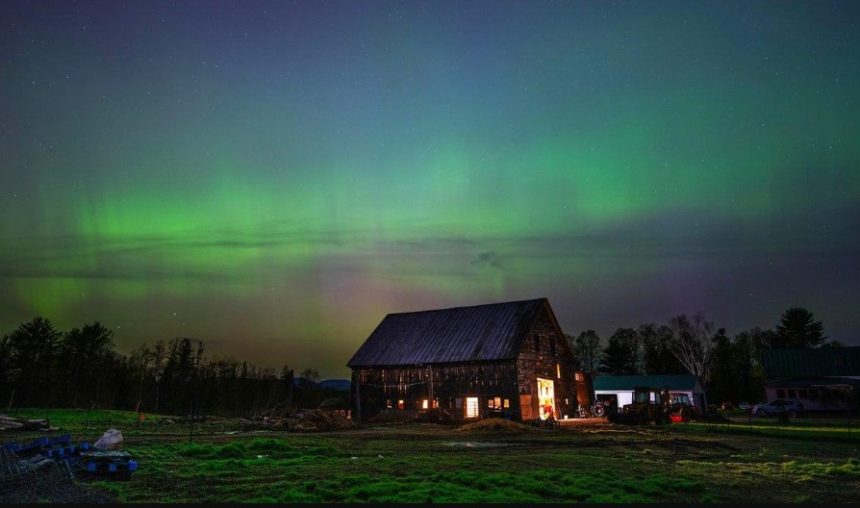The northern lights, or aurora borealis, have once again graced the skies of Florida, yes, you read that right.
The generally cold-rainfall miracle made a surprise return to the Deep South this week, turning the Sunshine State’s night sky a faint shade of pink and red.
The glowing display was caused by an important solar storm that hit Earth on Tuesday, 11 November, producing rare sightings of the light in unexpected places across the United States.
What left both locals and experts astounded was how far south the lights travelled, all the way to Tallahassee, the capital of Florida.
“Uh, did not expect to see the aurora from northern Tallahassee this evening,” wrote Wright Dobbs, a forecaster for the National Weather Service, on X (formerly Twitter).
Uh did not expect to see the #aurora from northern #Tallahassee this evening. Faintly visible to the naked eye as an extremely dim red glow. Long 25s exposure here and edit to bring out the color captured by the camera. #FLwx @spann @TamithaSkov pic.twitter.com/Ndgyp6NefP
— Wright Dobbs (@WrightDobbs) November 12, 2025
“Faintly visible to the naked eye as an extremely dim red glow. Long 25s exposure here and edit to bring out the colour captured by the camera.”
Social media is Snappily filled with prints of the Florida night sky glowing pink, with reports coming in from Tallahassee, Marianna, Titusville and Bryceville. For many, it was a once-in-a-lifetime sight, the Northern Lights appearing in the Deep South.
Florida’s Third Aurora Display
This marks the third time that Florida has witnessed the sunup borealis. In 2024, lights appeared twice, first in May and again in October.
On both occasions, the displays followed extreme rainfall events, including the Tallahassee williwaw outbreak and the ruinous Hurricane Milton.
Fortunately, this rearmost display came under calmer skies, though Floridians were still dealing with an early cold snap and indurate warnings as temperatures dipped surprisingly low for the region.
According to the National Oceanic and Atmospheric Administration (NOAA), this solar storm was strong enough to make the northern lights visible in at least 21 U.S. states, stretching from the Midwest to the Gulf Coast.
The agency advised that the stylish viewing hours were between 6 p.m. and 6 a.m. Central Time, with visibility potentially lasting into early Wednesday, 12 November.
Recently, the UK also witnessed a stunning aurora display across its night skies, with vivid colours captured from Scotland to northern England.
Why does the Aurora Borealis happen?
The sunspot borealis occurs when charged patches from the Sun collide with Earth’s magnetic field, producing beautiful glowing bands in the upper atmosphere.
These light shows, frequently seen in Arctic regions such as Norway and Iceland, can occasionally travel much further south when the Sun’s geomagnetic exertion increases during a solar storm.
The colours, from vivid greens to deep reds and purples, depend on which gases are being struck and at what altitude. Red auroras, like those seen in Florida, are often caused by high-altitude oxygen reacting with solar particles.
How to See the Northern Lights?
For anyone hoping to spot the northern lights in the UK or abroad, here are a few simple tips:
- Find a dark sky: Head away from street lights and cities, rural areas or open countryside offer the best visibility.
- Look north: In southern regions, the aurora often appears low on the northern horizon rather than overhead.
- Be patient: The best time to view is usually between 10 p.m. and 2 a.m., though activity can peak earlier or later.
- Use your camera: Even if your eyes can’t catch the colours clearly, a camera with a long exposure can reveal stunning detail.
How to Capture the Moment?
You don’t need a professional tackle to snap the aurora borealis. However, use a tripod and set it to homemade mode with a 10 – 15 alternate exposure, a wide orifice( around f/ 2, If you have a DSLR or mirrorless camera 8), and ISO between 1600 – 3200.
Still, switch on Night Mode, hold your phone steady, if you’re using a smartphone. Some modern phones even allow manual exposure control, perfect for capturing faint auroral light.
A Reminder of Nature’s Power
With the Sun presently in an active phase of its 11- time solar cycle, experts say there could be further sunup sightings further south in the coming months, conceivably indeed visible from corridor of the UK.
For Floridians, however, the experience was nothing short of surreal. Seeing the sunup borealis shimmering over win trees and flaxen strands is a rare treat, and a memorial of the inconceivable connection between our earth and the Sun.
So, coming time the cast mentions a geomagnetic storm, snare a jacket, find a dark spot, and look north, you might just catch one of nature’s most stunning shows.






